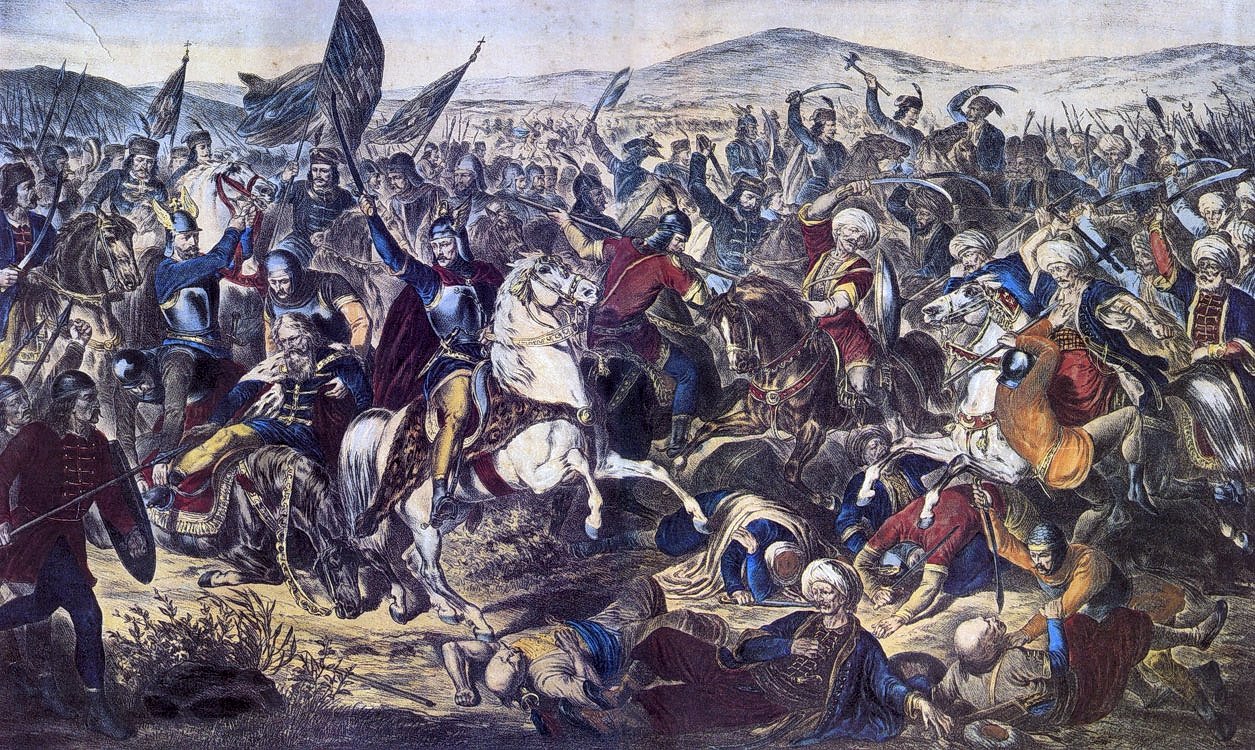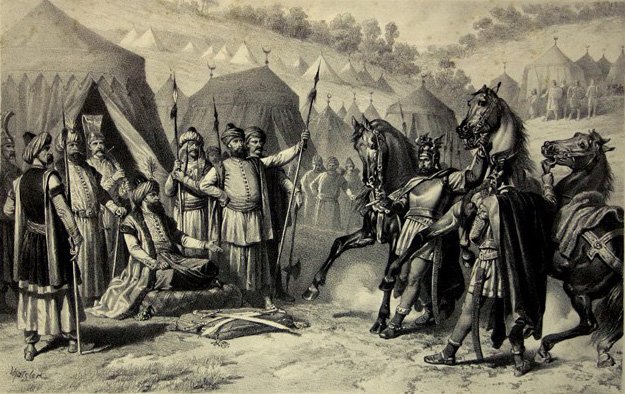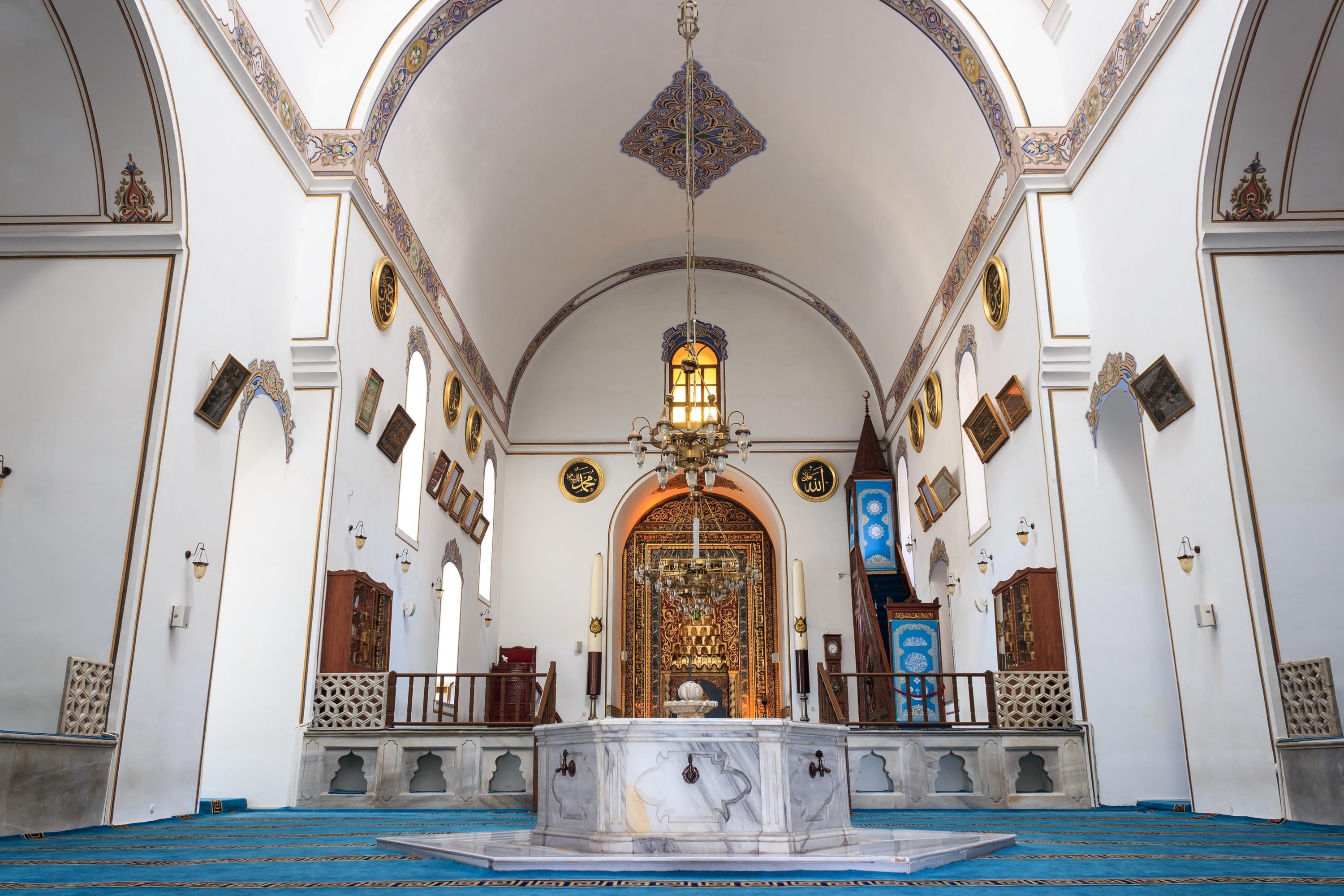© Turkuvaz Haberleşme ve Yayıncılık 2026
Although some Ottoman sultans died due to illness during military campaigns, one of them was truly martyred in a war. This sovereign was Sultan Murad I, the son of Orhan Ghazi. Sultan Murad was referred to by the titles of “Hodawendgar” and “Gazi Hünkar.” While Hodawendgar means chief or master in Persian, Ghazi Hunqar means veteran ruler in Turkish. The vilayet (province), the center of which was Bursa, was called Hodawendgar to honor his memory until the end of the Ottoman Empire.
The mother of Sultan Murad was Nilüfer Hatun, who was the daughter of the Byzantine Governor of Yarhisar and was previously called Holofira before converting to Islam. Every shahzade (prince) was trained by an experienced statesperson called “lala” in the Ottoman Empire. The tutor of Murad I was Lala Şahin Pasha. Sultan Murad was assigned as the sanjak bey (the title given in the Ottoman Empire to a bey appointed to the military and administrative command of a district) of Bursa at a young age, which provided him a great experience. When his elder brother Süleyman Pasha died in a hunting accident in 1359, he became the heir to the throne. He was the commander of the army in Rumelia in this year and ascended to the throne as the successor of his father, who died the following year.
Since political power was seen as the common property of the dynasty in the old Turkish tradition, his two brothers Ibrahim and Halil rebelled against Sultan Murad. Thus, Murad suppressed the first shahzade revolts in Ottoman history.
After conquering Ankara and Ereğli (Heraclia) on the Black Sea coast, Sultan Murad I headed to Rumelia as the Byzantine Empire made an alliance with Venice and attempted to occupy the Ottoman lands there by taking advantage of the sultan's occupation in Anatolia.
Edirne, which was called Adrianople back then, belonged to the Byzantine Empire at that time, but the locals were not happy or satisfied with the administration. In an uprising in 1345, the notables of the city were put to the sword. Sultan Murad evaluated this situation and conquered Edirne in 1363 at the Battle in Sazlıdere. The government headquarters was moved to Edirne, and tens of thousands of Turks brought from Anatolia were settled in uninhabited lands in the city.
The sultan was determined to conquer the entire Balkans. So, he set up four fronts here, conquered Kırklareli and reached the Black Sea. He commissioned Evrenos Bey with the conquest of Western Thrace while charging Lala Şahin Pasha with the conquest of southern Bulgaria. Stara Zagora, Plovdiv (Filibe) and Komotini (Gümülcine) were conquered, thus the Byzantine Empire and Bulgaria; Serbia and Bulgaria; and Albania and Serbia were separated from each other. When the Byzantine Empire realized that it would not receive support from the locals, it gave up hope of expelling the Ottomans from Rumelia and agreed to come to terms and recognized these conquests.
This progress of the Ottomans, which the Byzantine Empire could not prevent, worried the Christian world. It did not seem possible for the Serbians and Bulgarians to resist it either. Venice did not want to start a war with the Ottomans and jeopardize its commercial interests in the East. The only force that could resist them would be the Hungarians, who wanted to Catholicize the Balkan people.
The army formed by the kings of the Hungarians and Serbians along with the prince of Bosnia and Wallachia with the encouragement of Pope Urban V – the head of the Catholic Church – was destroyed in a night raid near Edirne by a reconnaissance unit under the command of Ottoman commander Hacı Ilbeyi in 1364. After this victory, known as “Sırpsındığı” (Rout of the Serbs), Serres and Biga, a coastal town on Anatolia's Marmara shores still under Byzantine control, were conquered. The Republic of Ragusa, centered on the Adriatic port city of Dubrovnik, accepted Ottoman suzerainty to keep its lucrative trade routes. It became the cannon casting center of the Ottomans.
The Ottomans were welcomed by the Rumelian people. The Greek Patriarch praised Sultan Murad for his tolerance toward the Orthodox in a letter to Pope Urban VI in 1385. In the face of the Catholic threat, it was natural for the Orthodox people to prefer the Ottomans.
The period of peace that started with these developments gave Sultan Murad the opportunity to improve the country. He commissioned an imaret (soup kitchen for the poor) and tekke (lodge) in Yenişehir; three mosques, an imaret, a madrassa, a thermal spring and an inn in Bursa; a mosque, a madrassa, an imaret and a palace in Edirne along with a mosque in Bilecik. Bursa became one of the brightest scientific and cultural centers of the Islamic world during his time.
Although the Byzantine Emperor John V Palaiologos sought support from Europe, he did not succeed. The Serbian and Bulgarian allied army was defeated by the Ottomans in Samokov in 1370. The gates of northern Bulgaria were opened to the Ottomans and Kyustendil fell. Thus, the Ottomans gained a foothold in Serbia.
The Serbian and Wallachian allied army wanted to try its luck again but was defeated in Çirmen (Tshronomen, Chernomen, modern day Ormenio) in 1371. Macedonian gates were wide open to the Ottomans now. The people, fed up with the Serbian and Bulgarian administration, accepted the Ottoman rule. Drama, Kavala and Bitola fell. North Macedonia and Kosovo were also conquered.
Ottoman raiding units, the advanced troops of the Ottoman Empire, reached the Dalmatian coast. The king of Serbia and the Bulgarian king recognized Ottoman suzerainty in 1372 and 1376, respectively. Nis, one of the most important cities of Serbia, and the place where Roman Emperor Constantine the Great was born, was captured by the Ottomans. Starting from 1380, the Ottomans conquered cities such as Prilep, Sofia, Nis, Bitola, Ohrid and Shkodra in order to consolidate their position in Rumelia. Thereupon, the Byzantine emperor recognized the Ottomans as sovereign and accepted to pay tribute in 1373.

Meanwhile, Murad’s son Shahzade Bayezid married Devlet Hatun, the princess of the beylik of Germiyanids, in 1378. The bride brought the cities of Kütahya, Tavşanlı, Emet and Simav as dowry to the Ottomans. Cities such as Akşehir, Yalvaç, Beyşehir, Seydişehir and Karaağaç were also purchased from the beylik of Hamid. The beylik of Isfendiyar in Kastamonu, ruled by the brother of the Sultan's wife, Gülçiçek Hatun, recognized the Ottomans as sovereign.
In 1385, Shahzade Savcı Bey rebelled against his father in Bursa. He was defeated, captured and executed in battle on the plain of Kete.
Ali Bey, who was the ruler of the Karamanids – which became a border neighbor with the Ottomans – was married to the sister of Sultan Murad. Nevertheless, he crossed the border while Sultan Murad was busy with military operations in the Balkans and attempted to invade and plunder Ottoman lands. This narrow-mindedness is one of the most important reasons why none of the Anatolian principalities could grow like the Ottomans and all of them disappeared over time.
When Sultan Murad heard about his brother-in-law's moves, he said: "Look at what this stupid cruel man has done! While I have devoted my life day and night to the war in the way of Allah, and while I was swinging the sword at the enemy in trouble; he is coming and attacking Muslims!” and easily dispersed the Karaman troops, which he marched on in 1386.
Shahzade Bayezid was helpful in this operation and received the title of "Yıldırım," meaning “Thunderbolt.” Ali Bey escaped and his wife came to his brother and demanded peace. Then Ali Bey came into the presence of the sultan and kissed the sultan's feet and asked for forgiveness. Thanks to this prudent policy, Ottoman influence spread in Anatolia.
Sultan Murad, who showed in his relations with the Anatolian principalities that success could not be won with the sword alone, was very careful not to cause trouble with the Venetians, who had a strong navy. If cities surrendered, he would give full security and freedom with an ahidname – an edict guaranteeing the rights of the people. Besides, Sultan Murad and Barquq, the Mamluk sultan of Egypt, both faced the threat of the Crusaders and made an alliance.
As soon as Sultan Murad returned, Ali Bey began negotiating with the Crusaders. However, he did not neglect to send a unit to the Battle of Kosovo a few years later due to his fear.
When an army of 30,000 troops constituted from a Serbian-Bosnian alliance defeated an Ottoman army of 20,000 soldiers in Ploshnik, breaching a treaty, in 1388, the Europeans were overtaken with excitement. As such they gathered a Crusader army to completely expel the Ottomans from the Balkans. Thereupon, Sultan Murad I immediately ordered the Grand Vizier Ali Pasha to launch a full-scale invasion of Bulgaria.
Despite this, the Serbian army continued to advance, but in 1389 they were devastated on the plains of Kosovo. The Serbian Prince Lazar fell. The Battle of Kosovo, which lasted for eight hours, stands as one of the most important events in Ottoman history. It consolidated the Ottoman dominance in the Balkans and determined the fate of the nations in the region. This was the historical battle in which the Ottomans used cannons for the first time. (According to another report, it was the Karaman expedition).
In Ottoman chronicles, it is said that Sultan Murad prayed in his tent the night before the battle, desiring martyrdom. It is said that he prayed as thus: “Oh my Allah! Sacrifice me for these Muslims; so long as they are not defeated and destroyed at the hands of the enemy!”
At the end of the battle, Sultan Murad was stabbed and martyred by the wounded Serbian knight Milos Obilic, who wanted to meet him in person. (It was after this incident that it became customary for foreigners who came before the Ottoman sultans to have one soldier on each arm). Sultan Murad was 63 years old when he died. Although he was martyred on the battlefield, the enemy could not take advantage of this and advance.
His temporary tomb, which was constructed upon the spot where he was martyred, is considered a sacred place visited by Muslims today and a symbol of Ottoman domination in Rumelia. The body of the sultan was brought to Bursa and buried in the tomb of the mosque he had built. The martyrdom of a ruler in such a victorious battlefield caused so much distress in the Islamic world that Egyptian Sultan Barquq sent a candlestick, a bowl and a mushaf (written form of the Quran) to be placed in Sultan Murad’s tomb in Bursa.
Sultan Murad established the office of the “kazasker” in 1361 as the equivalent of the “qadi al-qudat” (chief justice of the highest court). The office was responsible for appointing and controlling the “qadis” (judges) in the previous Islamic states. Kazasker was the leader of the “ulama” (Islamic scholars), which included the courthouses and the education bureaucracy.
The Ottoman army was constituted of two units from the “yaya” (pedestrian) and “müsellem” (cavalry), which were the infantry and cavalry troops, respectively. These units would join wars for a fee, and during peacetime would be busy with private affairs, for example, agriculture. Due to the increase in military operations, a permanent and paid army was needed during the reign of Sultan Murad.

According to Islamic law, one-fifth of those captured in war belonged to the state. Until then, this amount was sent to the Seljuk sultan. In 1362, with the efforts of Karamanlı Kara Rüstem and Çandarlı Kara Halil Pasha of the ulama, the “pençik law,” pençik meaning one fifth from the Persian words of “penç” (five) and “yek” (one), was prepared. This decreed that among one-fifth of captives, those who were suited to become statesmen or soldiers would be trained as such. Thus, the basis of the Ottoman bureaucracy and the Kapıkulu corps, the Household Division of the Ottoman Sultans, was established.
Sultan Murad was of medium height, had a round face, curved nose and big eyes, while he had a wide scowl, a sparse beard, a broad chest and long fingers.
His first wife, Gülçiçek Hatun, was the daughter of Candaroğlu Süleyman Bey. In some sources, it is said that she was of Greek origin. He also married Tamara, the sister of the Bulgarian King Ivan Shisman; Maria, daughter of Byzantine Emperor Ioannis V Paleologos and daughter of Bulgarian Prince of Kyustendil for political reasons. The eldest son of Ivan Shishman, Alexander, converted to Islam under the name Iskender and died as sanjakbey of Manisa.
He had five sons, namely; Sultan Bayezid I, Yahşi Bey, Yakub Bey, Savcı Bey and Ibrahim Bey. He also had four daughters, one of whom was married to a ruler of the Sarukhanids and two of whom were married to rulers of the Karamanids.
Sultan Murad was extremely religious and was respectful to scholars and Sufi saints. Every Friday prayer, he would give alms to the poor. He was seen as a saint among the people and his miracles were noted. For example, rumor has it that when the siege of Pleven lasted for 15 days and the castle could not be conquered, he said: “It is difficult to take this castle. I hope God destroys it!” At that very moment, a wall of the castle collapsed following a loud noise.
Greek historian Chalkokondyles says: “He personally participated in 37 battles. He was brave and never complacent. He was adept at arranging his affairs and doing everything in due time. He was as energetic in his old age as he was in his youth. He was cautious. He treated his entourage well. He spoke little, and when he did speak, he uttered kind words. He was a benevolent ruler, a tireless hunter and a kind knight.”
Romanian historian Nicolae Iorga says: “He was generous and gracious towards Muslims and was a gentle ruler who knew how to win hearts of Christians instead of winning against them.”

Slavic historian Antun Dabinovic says that: “Murad was not just a powerful politician but was a first-class commander. He would stick to his promise. He was very tolerant. He would not tolerate acts that violated the policy of the state.”
French historian Fernand Grenard says: "He was almost an innate ruler, who was unprecedented as his personality in Europe of the time."
During his reign, which lasted for 29 years, he gained many victories and never experienced the brutal face of defeat. He enlarged the lands he inherited from his father five times and left a country of 500,000 square kilometers (193,050 square miles) to his son Sultan Bayezid. These lands remained under Ottoman rule for five centuries.
British historian Edward Gibbons says: “Osman Ghazi gathered a nation around him; Orhan Ghazi created a state; but the empire was established by Murad Hodawendgar.”
